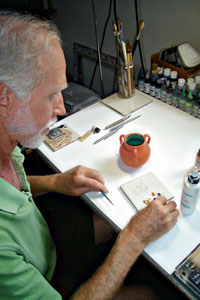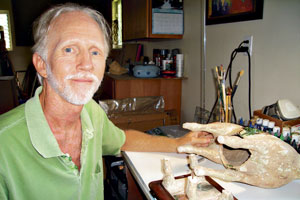Restoring Old Collectibles
Mark Nilsson
Owner of Repairs and Restoration of Antiques and Collectibles
Please tell us about your business.
I repair and restore antiques, collectibles — any items of sentimental value. I work out of my home in Kilauea on all types of items, mostly small, like figurines and dishes. They can be made of anything from ceramic and wood to china and plastics. A big thing in Hawai‘i, for example, are valuable Hawaiiana items, and many of those are plastic. People would purchase these products in the ’40s and ’50s and bring them back as souvenirs, and now they’re very collectible and valuable.
What are some of the ways you repair and restore items?
First, I assemble the pieces, and sometimes that’s like putting together a jigsaw puzzle. I glue them back together. So then there are always pieces that are going to be missing — slivers or large pieces that I have to fill in. I have certain fillers that are made for porcelain that I use to fill in, and once that hardens, I sand it down to make it smooth. Then I paint it and airbrush, unless it’s something that needs to be done by hand.
How do you match the colors so well?
It’s kind of an innate thing. For some reason, I can look at any color and just go right to my colors and pick out the exact ones to mix. I don’t have any problem mixing colors. I don’t even have to think about it. I know how colors work together and how to blend them.
When did you first realize you had that talent?
I was about 10 or 11 years old. I was in the basement of my house and there was a bed down there, and I was doing somersaults, as a kid would do, and my heel went into the drywall and left a big hole there. I made a model train at the time, and so I covered the hole with plaster and mixed the colors from the model train, painted it and no one ever knew. That was my first restoration project.
How did you get started in this business?
My mother was an antique dealer in Denver, and she knew that because I’m an artist, I’m good at mixing colors and molding whatever was needed to repair a piece. She suggested I go to school to learn, and because she was a dealer, she had a lot of connections that kept me busy when I first started.
Who are some of your clients?
Residents who have sentimental pieces and heirlooms that need to be fixed, and I restore pieces for a lot of the shops on-island like Serendipity and Island Chic. I also restore the porcelain collection at the Grove Farm estate. In addition, I still do work for dealers in Colorado.
What is the value in restoring items for stores?
Something can have a small chip, break or crack and they can buy it next to nothing, and I can repair it so that it’s invisible — you can’t tell it’s been broken and you can get about 80 percent of your value back in return. It’s a good return, so that’s why it works so well for dealers.
What sets your business apart?
My ability to do porcelain repairs. That’s why I still get things sent in from Colorado because they don’t have anyone to repair porcelain there. There aren’t many people who take it up or have any interest in doing it.
What is the most rewarding aspect of what you do?
When they break something, people get really sick about it and don’t realize that it can be restored. But when they find out that it can and bring me something, and it comes back looking like it was never broken, they are elated. Everybody has something that’s been broken that has sentimental value that can be fixed.
What is the most challenging aspect of what you do?
Sometimes when I get a piece the answer to exactly how to fix it won’t come right away, and I have to sit with the piece and the piece kind of communicates to me. Then the answer comes and then I’m able to repair it, so sometimes I just need to sit with the piece for a while.
How long does it typically take to repair something?
Because it’s a five-step process, I need time between each stage, about 24 hours. So, for example, I can put together several pieces in a day, and that’s the first stage, and I have to let those completely dry. And then I do the filling and sanding stage, and that’s another whole day because the fillers take 24 hours to dry. And then, of course, matching the paint and then the final glaze. It can be a five-day process.
What is one of the most memorable pieces you’ve worked on?
A vase that was broken in the 1906 earthquake in San Francisco and was restored back then. It came to Colorado and my neighbor had it, and had a maid who broke it. So I had to completely take the old restoration back apart and restore it back to its original. It was probably made in the late 1800s or so.
What motivates you to go to work every day?
I love my work and have a passion for it. And knowing that I can restore something and return it to somebody and make them happy about it.






